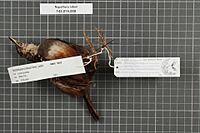Cordillera ground warbler facts for kids
Quick facts for kids Cordillera ground warbler |
|
|---|---|
| Conservation status | |
| Scientific classification | |
| Genus: |
Robsonius
|
| Species: |
rabori
|
| Synonyms | |
|
Napothera rabori |
|
The Cordillera ground warbler (Robsonius rabori) is a special type of bird found only in the Philippines. It lives in the forests of northwest Luzon, near the Cordillera Mountain Range. This bird is quite unique because it is found nowhere else in the world! Sadly, it is considered a vulnerable species, which means its numbers are decreasing. This is mainly because its forest home is slowly disappearing.
Contents
What Does It Look Like?
The Cordillera ground warbler is about 20 to 22 centimeters (about 8 to 9 inches) long. It has noticeably long legs, a long beak, and large feet. Its head is a rusty-chestnut color with a thin white ring around its eye. There's also a small patch of bare gray skin behind its eye.
Its throat is white, with black tips on the sides. The chest is a medium gray, and it has a clear grayish triangle pattern on its belly, which is white. The bird's wings are chestnut to dark brown. When folded, they look mostly chestnut. It also has brown upper parts with two white dotted lines on its wings.
This bird sings very high-pitched songs. They sound like tseeee sip tseeee! These songs usually last between 1.6 and 2.2 seconds.
How Is It Different from Other Birds?
You can tell the Cordillera ground warbler apart from its relatives, the Bicol ground warbler and Sierra Madre ground warbler. It has unique grayish triangular markings on its belly that the others don't have.
Naming the Cordillera Ground Warbler
The Cordillera ground warbler was first described by a Canadian scientist named Austin L. Rand in 1960. He gave it the scientific name Napothera rabori. The second part of its name, rabori, was chosen to honor Dioscoro S. Rabor. He was a Filipino scientist who collected the first example of this bird on the island of Luzon.
Ground warblers were first found in 1959 by a team led by Dioscoro S. Rabor. They walked through the forests, listening for bird calls. They first found two types, which are now called the Cordillera ground warbler (Robsonius rabori) and the Bicol ground warbler (Robsonius sorsogonensis). The Bicol ground warbler was seen for the first time in 1961. These birds mainly differ in their colors and where they live.
At first, scientists thought these birds were related to other Asian babblers and put them in the genus Napothera. But later, after studying their bodies, how they act, and their family tree, scientists decided they belonged to a different group called Robsonius. In 2013, a brand new species was discovered: the Sierra Madre ground warbler (Robsonius thompsoni).
Life in the Forest
Building a Home
Scientists don't know much about how the Cordillera ground warbler builds its nest. What they do know is that nests are often found on rock cliffs. They are made of wet sticks, branches, and leaves. The nest is shaped like a dome and has an entrance. Twigs and mud help hold the dome onto the rock.
What Does It Eat?
The Cordillera ground warbler mainly eats small creatures without backbones, like insects. It has been seen searching the forest floor, looking for food hidden under leaves.
Where It Lives and Why It Needs Help
Its Forest Home
The Cordillera ground warbler lives on the island of Luzon in the Philippines. You can find it in the northwest part of Luzon, especially in the Cordillera Mountain Range. It prefers moist lowland forests, including old-growth forests, newer forests, and the edges of forests, up to 500 meters (about 1,640 feet) high. It usually stays on the forest floor among limestone rocks, bamboo, and mossy areas.
Why It's Vulnerable
The IUCN (International Union for Conservation of Nature) has listed this bird as vulnerable. This means it faces a high risk of becoming extinct in the wild. There are an estimated 2,500 to 9,999 adult birds left. Among the three types of Robsonius ground warblers, the Cordillera ground warbler is the most endangered. This is because it has the smallest area where it can live.
The biggest danger to this bird is habitat loss. This happens when its forest home is completely cleared away. This clearing is due to logging (cutting down trees), converting forests into farmland, and mining activities in the area where the bird lives.
Protecting the Warbler
This species is currently protected within the Northern Sierra Madre Natural Park and Kalbario–Patapat Natural Park. However, like many protected areas in the Philippines, the rules are not always strictly followed.
Scientists have suggested several ways to help protect this bird. These include finding out exactly how many birds there are and starting a program to watch their numbers over time. They also want to learn if the bird can survive in forests that have been partly damaged. It's also important to find and understand all the threats to the bird. Finally, they want to make sure that the Northern Sierra Madre Natural Park and Kalbario–Patapat Natural Park are protected more effectively.




